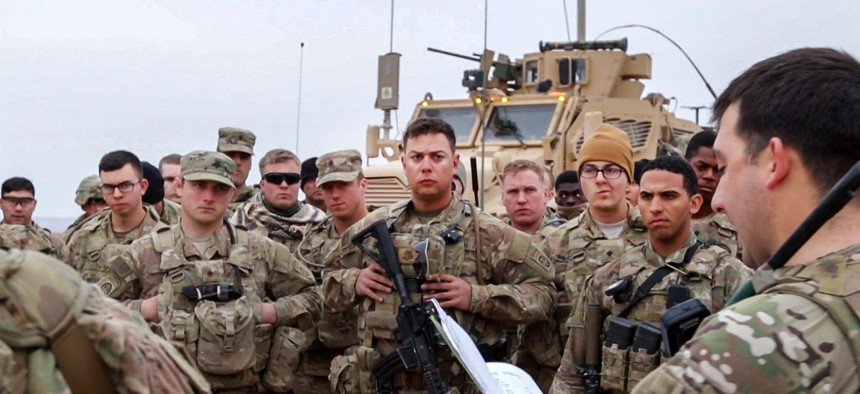
U.S. Army Rangers are briefed south of Mosul at Qayyarah West Airfield, Iraq, Feb. 17, 2017, before moving out to Hamam al-Alil. CJTF-OIR Photo by Staff Sgt. Jason Hull
Three Lingering Questions For Trump's New Plan to Fight ISIS
If Trump sends more American boots to Syria, who will fight alongside them, and — stiil — what comes next?
Right now, the U.S. military is finalizing its options in Syria for President Donald Trump. The troop caps of the Obama era are a thing of the past. At least for now. These personnel limits, so popular among some in Washington, served as brakes against accelerating conflicts, made art of numbers, and led to some military units being broken up and deployed in different pieces. Or in the case of the 101st Airborne Division, deploying some soldiers while forcing the Army to leave its helicopter mechanics behind.
As military planners look ahead to the next stage in the ISIS fight, three questions present themselves:
1) Is the "no boots on the ground" era over, in Syria?
Will Obama’s “no U.S. boots on the ground” policy that large ground forces must be avoided in Syria at all costs come to an end alongside the troop caps?
Right now the answer is: more Americans may go in. But don’t look for American troops in combat roles. “Advise and assist” remains the guiding principle.
Obama publicly remained steadfast on “no boots on the ground,” but quietly sent special operations units both to Iraq and to Syria. Already Army Rangers are providing security in Manbij and Marines, in the area around Raqqa, are in Syria to hoist U.S. flags and keep Russian and Syrian forces at bay. The question is: how many more are coming? And can the mission be contained to remain support rather than fight?
“Coalition forces have continued to train, advise, assist and accompany Manbij Military Council forces as they provide security to the people of Manbij and restore local governance and public works to the city,” Combined Joint Task Force Operation Inherent Resolve Spokesman Col. John Dorrian said. “[The] coalition is in part a reassuring presence for partner forces that they can rely on to ensure the focus is against ISIS as we turn toward Raqqa.”
Despite Trump speaking of the virtues of a no-fly zone, few inside the administration expect to see them come any time soon given the possibility such a space could put the U.S. in direct conflict with Russian forces backing the Syrian regime.
The new president has not made clear how exactly he sees the role of U.S. ground forces in the fight against ISIS. But he has made clear he wants such options on the table for him to weigh.
RELATED: SPECIAL REPORT: The Military Loves the Obama Doctrine. Can It Survive Trump?
RELATED: US Special Operators Accelerate Killings of ISIS Leaders
RELATED: Corruption Helped ISIS Take Mosul. Victory Cannot Last While It Persists
The key word, say those familiar with the plans, is flexibility. Commanders want to be able to move forces across the border between Syria and Iraq as the mission takes shape. And conditions on the ground are taking shape in extraordinary ways as northern Syria grows crowded with Russian, Turkish, Syrian, Iranian, and American forces.
That leads to the next question, which has been brewing for months.
2) Who will fight ISIS alongside the US?
Turkey sees Syrian Kurdish forces as terrorists connected to their own outlawed PKK. And Turkey has made no secret of its desire to see the U.S. divorce itself from the YPG and YPJ. At the same time, U.S. military leadership sees these People’s Protection Units as among America’s most battle-tested and reliable allies on the ground, a force both willing and formidable. These forces moved closer to the U.S. when the Obama administration opted to fight this war “by, with, through” local soldiers.
In other words, America’s challenge right now is to lead the war without leading the battle and to shepherd the fight without losing its allies to infighting.
Secretary of State Rex Tillerson will have to search for calm diplomatic waters when he travels to Turkey at month’s end. He is the latest American official — from the Obama administration and, now, the Trump cabinet — to come calling on Turkey to cool tensions with the coalition and stay focused on ISIS. Turkish officials have said publicly they do not want to see Kurds involved in the fight for Raqqa and that U.S.-Turkish relations will be hurt if they do.
Part of Tillerson’s agenda will be to preserve that U.S.-Turkish relationship. And to keep it from becoming a casualty of the Raqqa campaign.
Add Russia to the mix, and it’s become so complicated and sensitive that Joint Chiefs Chairman Gen. Joseph Dunford last week traveled unannounced and without reporters to meet with his Turkish and Russian counterparts. The leaders posed for a photo op. This week, U.S. military officials in Baghdad said the path forward remains a work in progress.
“As far as a role for Turkey, we have made clear from -- of many, many weeks, actually months, that we are open to a Turkish role in the continued operations to defeat ISIS in northern Syria,” Dorrian said, in a video press conference with Pentagon reporters. “We don't -- we haven't come to an agreement about what that role will be or if there will be one, but we talk to Turkey through military channels and I believe at diplomatic levels every day.”
3) What happens after Raqqa?
The fight for Raqqa is now on the horizon. But the “…and then what?” question remains, and U.S. generals are asking it.
“The grievances of the civil war have to be addressed, the safety and humanitarian assistance that needs to be provided to people have to be addressed, and the multiple divergent stakeholders’ views need to be addressed,” said Gen. Joseph Dunford, chairman of the Joint Chiefs of Staff, in February. “We do need to have a vision of how our military actions set conditions on the ground that actually then become the platform from which Secretary Tillerson goes to Geneva to come up with a political solution.” Dunford said the plan the Pentagon will deliver to Trump will not be a military-only plan, rather it will include post-conflict political needs that require whole-of-government efforts.
But while Dunford, CENTCOM’s Gen. Joseph Votel, and other military leaders want White House support for more than military action, the Trump administration has said it will not do nation-building and proposed deep cuts to the State Department, traditionally the architect of ending wars and keeping them ended.
How does the U.S. make certain that any end to ISIS does not create a vacuum that leads straight to the start of its successor organization and, eventually, sends U.S. forces back to the region once more? And how do military officials find a partner for development and diplomacy under an administration that sees much of what the State Department does as superfluous?
In the next few weeks, these three questions will take center stage. The American public would do well to engage with them as potentially thousands of additional U.S. troops look headed to Afghanistan, Iraq, and Syria. Obama may have said in 2011 that “the tide of war is receding,” but he found it impossible to end America’s post-9/11 conflicts. His successor, who shares the Obama desire to pursue “nation building here at home,” may find the same challenge.





